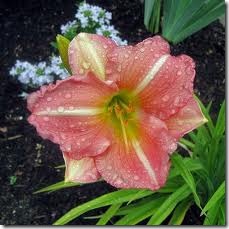The scientific name for daylily is Hemerocallis, which means "day beauty." This is a fitting name because each flower on this lovely plant lasts for only a day. However, flowers come by the hundred during the hot summer months common to Alabama. Daylilies should not be confused with real lilies. Daylilies are a much tougher plant and grow well even in poor soil. These tall perennials have sturdy stems and have been bred to come in a wide variety of colors and sizes. The daylily is an ideal flower to grow in Alabama because this state is known for its pleasant, year-round weather and its relatively long growing season.
- Difficulty:
- Easy
Instructions
 "Mary Todd" daylilies are known for their deep yellow color and ruffled edges.
"Mary Todd" daylilies are known for their deep yellow color and ruffled edges.
Plant daylilies in groups, utilizing moist soil that has been well-drained. Choose an area of the yard or garden that receives full sun. Full sun does not usually pose a problem for growing daylilies in Alabama because even during the hottest month of July, temperatures in this state generally remain in the 90s during the day and drop down in the 70s in the evenings. Daylilies can also be grown in partial shade, but be aware that these vigorous plants produce fewer blooms when planted in light shade.
- Water new plants often until they have become well-established. Cities in Alabama, such as Birmingham, generally receive an abundant supply of rainfall, and according to the Alabama Cooperative Extension Service, you should only water established daylilies if there happens to be an extended dry spell, or just before and after the plants flower.
 The arching leaves of daylily plants are quite attractive.
The arching leaves of daylily plants are quite attractive.
Fertilize daylilies grown in Alabama sparingly. Overfertilizing can cause the grasslike leaves to grow much too profusely, as well as reduce flower production. Provide mulch using pine needles, pine bark or leaves to create a layer that is 2 to 3 inches thick.
- Pinch off old, wilted flowers as they appear on daylilies grown in Alabama. This process is called "deadheading," and it helps to encourage daylilies to produce new flowers. Authors Toby and Lisa Buckland state that the entire flower-spike should be cut off at the bottom when there are no more flowers budding.
- Divide daylilies and replant them in dispersed areas when it becomes evident that daylilies have stopped multiplying and have outgrown their location. This will give their root systems adequate space to expand and take in nutrients. Late fall, late winter or early spring are the ideal times of year to do this in the state of Alabama.
- Cut off daylilies at the ground level after the foliage has died during the winter. Although daylilies in Alabama are quite resistant to many pests and diseases, you should remove the old plants to prevent snails and slugs from hiding out during the colder Alabama months of mid-December to mid-February. Winters in this state are relatively mild and fresh plants should come up nicely during the spring.
Tips & Warnings
-
Try daylilies in a salad. These flowers are edible and have a crunchy texture that is sweet and somewhat onionlike.
-
Real lilies are poisonous and should not be eaten.


Deprecated: strpos(): Passing null to parameter #1 ($haystack) of type string is deprecated in /home/agriviek8Qv/agriviet.net/public_html/wp-includes/comment-template.php on line 2522